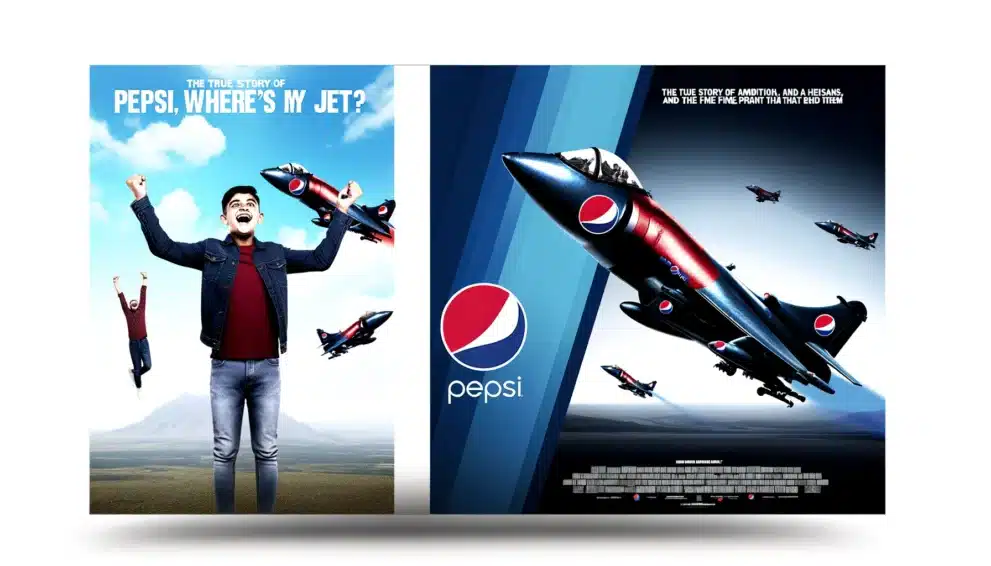
“Pepsi, Where’s My Jet?” is a compelling narrative that centers around a unique and audacious challenge posed by a major soft drink company to its consumers in the mid-1990s. This story unfolds against the backdrop of Pepsi’s promotional efforts, which, in a bid to outshine its competitors and engage directly with its audience, offered a variety of rewards through the collection of Pepsi Points. These points could be accumulated by purchasing Pepsi products and then redeemed for merchandise ranging from t-shirts and sunglasses to, most notably, a Harrier II jump jet, humorously priced at 7 million Pepsi Points.
The twist in the tale emerged when a resourceful and ambitious college student, John Leonard, decided to take Pepsi’s offer at face value. Leonard, spotting the Harrier jet listed in the Pepsi catalog, embarked on a quest to obtain it by exploiting a loophole in the promotion’s rules. Recognizing that the cost of directly purchasing millions of Pepsi Points would be prohibitive, he instead turned to a clause that allowed participants to buy additional Pepsi Points at a fraction of the cost needed to amass points purely through purchasing drinks.
Pooling resources and gathering support from investors, Leonard managed to raise the funds required to ‘purchase’ the 7 million Pepsi Points needed for the jet. His attempt to redeem the points for the Harrier jet was met with disbelief and refusal by Pepsi, which had intended the jet offer as a whimsical exaggeration to entertain and engage, not as a genuine reward.
The ensuing legal battle between Leonard and PepsiCo attracted widespread media attention, highlighting the nuances of advertising, promotional promises, and the responsibilities of corporations to their consumers. Pepsi defended its position by arguing that the jet offer was clearly intended as a joke, an argument that was eventually upheld in court. The judges concurred that the advertisement was an evident exaggeration and that the company was not obligated to fulfill such an extravagant reward.
“Pepsi, Where’s My Jet?” thus serves as a fascinating case study in marketing, legal boundaries, and consumer relations. It underscores the importance of clear communication in promotional activities and the unexpected challenges that can arise when imaginative advertising campaigns are taken literally by the public. The saga also reflects on the evolving dynamics between corporations and consumers, illustrating the power of creative engagement and the potential pitfalls of ambiguous promises.
Who is Todd Hoffman in “Pepsi, Where’s My Jet?”
Todd Hoffman played a crucial role in the story of “Pepsi, Where’s My Jet?” as the businessman who supported John Leonard in his attempt to claim a Harrier jet from Pepsi. Hoffman was instrumental in Leonard’s plan, providing the financial backing and strategic guidance needed to navigate the unique challenge posed by the Pepsi Points promotion.
The narrative begins with Pepsi’s promotional campaign, which included a commercial that humorously listed a Harrier II jump jet as a potential reward for 7 million Pepsi Points. Seeing an opportunity in what seemed to be a playful, if not outright ludicrous, offer, Leonard set out to take Pepsi up on its apparent promise. However, the enormity of acquiring 7 million Pepsi Points through purchasing Pepsi products was daunting and financially impractical.
Enter Todd Hoffman, who saw potential in Leonard’s audacious plan. Together, they leveraged a provision in the promotion’s rules allowing participants to buy Pepsi Points for 10 cents each after the first purchase of a Pepsi product. Calculating the cost, they realized that for a fraction of the jet’s actual value, they could theoretically acquire enough points to redeem for the Harrier jet.
Hoffman and Leonard proceeded to gather the necessary funds, with Hoffman’s business acumen playing a key role in this endeavor. They then submitted an order for the jet, along with a check for the additional points needed to reach the 7 million mark, to Pepsi. This move was met with disbelief and a refusal from Pepsi, which maintained that the jet offer was a joke and not a genuine reward option.
The dispute escalated to a legal battle, drawing significant media attention and sparking debates about the nature of advertising, promotional commitments, and the extent to which companies are bound by the offers they make, even in jest. Throughout this process, Todd Hoffman’s involvement highlighted the intersection of ambition, interpretation of promotional messaging, and the complexities of corporate promotions.
In the end, the court ruled in favor of Pepsi, agreeing that the commercial was an obvious exaggeration and that the company was not legally obligated to provide the jet. Hoffman’s role in the saga underscores the lengths to which individuals might go when they see an opportunity to challenge corporate giants, as well as the potential for creative interpretations of marketing campaigns to lead to unforeseen consequences




 Share
Share Tweet
Tweet Share
Share




Comment